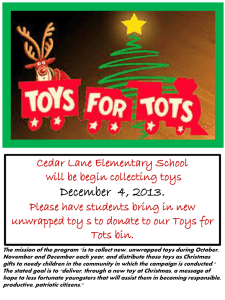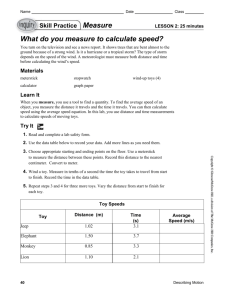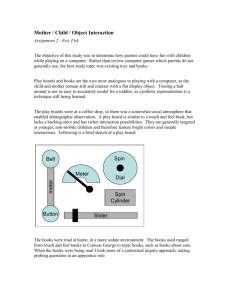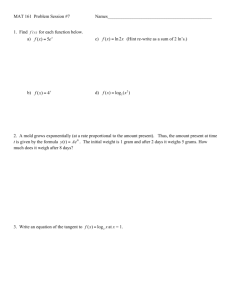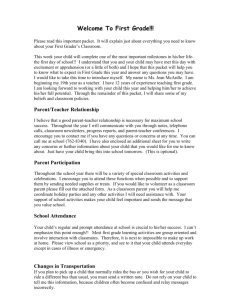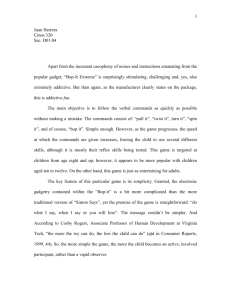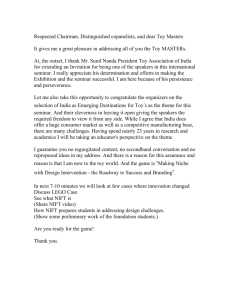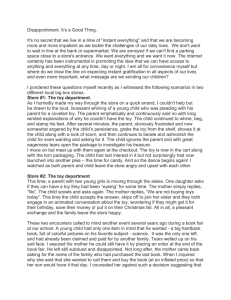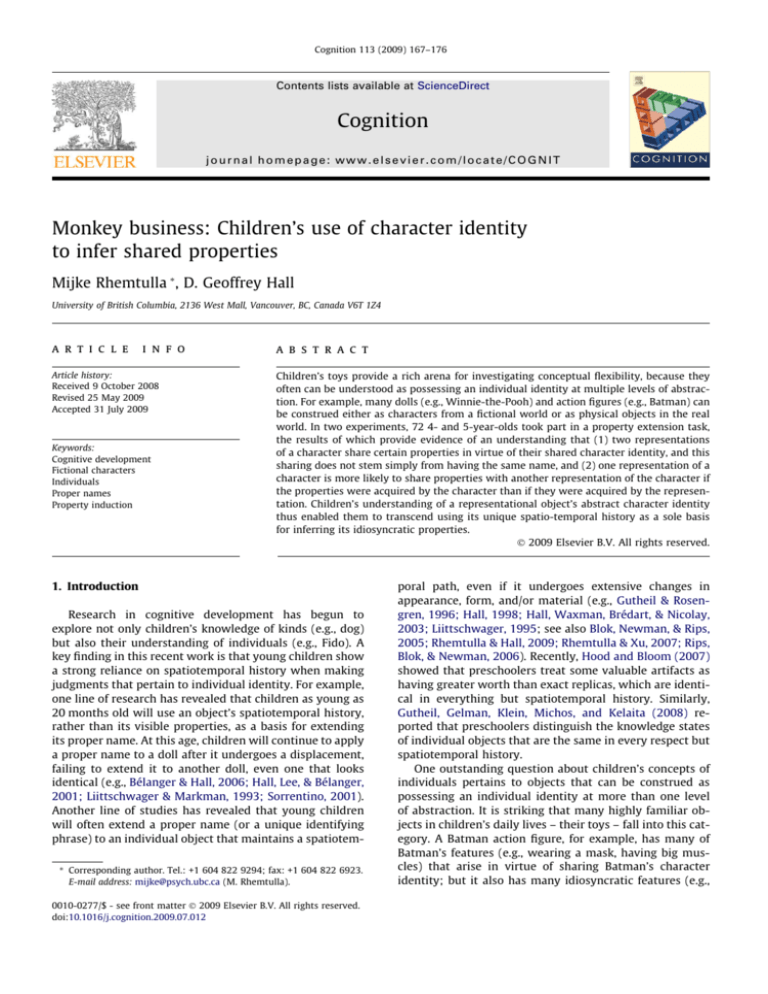
Cognition 113 (2009) 167–176
Contents lists available at ScienceDirect
Cognition
journal homepage: www.elsevier.com/locate/COGNIT
Monkey business: Children’s use of character identity
to infer shared properties
Mijke Rhemtulla *, D. Geoffrey Hall
University of British Columbia, 2136 West Mall, Vancouver, BC, Canada V6T 1Z4
a r t i c l e
i n f o
Article history:
Received 9 October 2008
Revised 25 May 2009
Accepted 31 July 2009
Keywords:
Cognitive development
Fictional characters
Individuals
Proper names
Property induction
a b s t r a c t
Children’s toys provide a rich arena for investigating conceptual flexibility, because they
often can be understood as possessing an individual identity at multiple levels of abstraction. For example, many dolls (e.g., Winnie-the-Pooh) and action figures (e.g., Batman) can
be construed either as characters from a fictional world or as physical objects in the real
world. In two experiments, 72 4- and 5-year-olds took part in a property extension task,
the results of which provide evidence of an understanding that (1) two representations
of a character share certain properties in virtue of their shared character identity, and this
sharing does not stem simply from having the same name, and (2) one representation of a
character is more likely to share properties with another representation of the character if
the properties were acquired by the character than if they were acquired by the representation. Children’s understanding of a representational object’s abstract character identity
thus enabled them to transcend using its unique spatio-temporal history as a sole basis
for inferring its idiosyncratic properties.
Ó 2009 Elsevier B.V. All rights reserved.
1. Introduction
Research in cognitive development has begun to
explore not only children’s knowledge of kinds (e.g., dog)
but also their understanding of individuals (e.g., Fido). A
key finding in this recent work is that young children show
a strong reliance on spatiotemporal history when making
judgments that pertain to individual identity. For example,
one line of research has revealed that children as young as
20 months old will use an object’s spatiotemporal history,
rather than its visible properties, as a basis for extending
its proper name. At this age, children will continue to apply
a proper name to a doll after it undergoes a displacement,
failing to extend it to another doll, even one that looks
identical (e.g., Bélanger & Hall, 2006; Hall, Lee, & Bélanger,
2001; Liittschwager & Markman, 1993; Sorrentino, 2001).
Another line of studies has revealed that young children
will often extend a proper name (or a unique identifying
phrase) to an individual object that maintains a spatiotem* Corresponding author. Tel.: +1 604 822 9294; fax: +1 604 822 6923.
E-mail address: mijke@psych.ubc.ca (M. Rhemtulla).
0010-0277/$ - see front matter Ó 2009 Elsevier B.V. All rights reserved.
doi:10.1016/j.cognition.2009.07.012
poral path, even if it undergoes extensive changes in
appearance, form, and/or material (e.g., Gutheil & Rosengren, 1996; Hall, 1998; Hall, Waxman, Brédart, & Nicolay,
2003; Liittschwager, 1995; see also Blok, Newman, & Rips,
2005; Rhemtulla & Hall, 2009; Rhemtulla & Xu, 2007; Rips,
Blok, & Newman, 2006). Recently, Hood and Bloom (2007)
showed that preschoolers treat some valuable artifacts as
having greater worth than exact replicas, which are identical in everything but spatiotemporal history. Similarly,
Gutheil, Gelman, Klein, Michos, and Kelaita (2008) reported that preschoolers distinguish the knowledge states
of individual objects that are the same in every respect but
spatiotemporal history.
One outstanding question about children’s concepts of
individuals pertains to objects that can be construed as
possessing an individual identity at more than one level
of abstraction. It is striking that many highly familiar objects in children’s daily lives – their toys – fall into this category. A Batman action figure, for example, has many of
Batman’s features (e.g., wearing a mask, having big muscles) that arise in virtue of sharing Batman’s character
identity; but it also has many idiosyncratic features (e.g.,
168
M. Rhemtulla, D.G. Hall / Cognition 113 (2009) 167–176
being made of plastic, having ketchup stains) that arise in
virtue of its unique spatiotemporal history. Many toys
are representations of fictional characters from movies or
books, and as such, they are objects that share an individual identity with countless other representations of the
same character, while remaining numerically distinct individual objects in and of themselves. Gutheil et al. (2008)
used character toys (e.g., Winnie-the-Pooh dolls) to investigate children’s reliance on spatiotemporal history when
inferring the knowledge state of individual objects. On
one trial of their task, one Pooh ‘‘watched” as children
played a game in one room; then children moved to another room where an identical Pooh doll was present. Children were asked whether the second Pooh knew about the
events that the first Pooh had watched. Children’s responses showed that they considered spatiotemporal history to be necessary for attributions of an individual’s
knowledge state: Pooh 2, though physically identical to
Pooh 1, was not credited with knowledge of the earlier
events.
Gutheil et al.’s (2008) study is important because it reveals that preschoolers are able to view two representations of the same character as distinct individuals with
distinct properties. In the current research, we looked at
the flip side of this issue: can children view numerically
distinct (and perceptually distinctive) representations of
the same character as having properties in common in virtue of sharing a character identity? Gutheil et al.’s evidence
that children rely on spatiotemporal history when judging
the knowledge states of individual objects suggests that it
may be difficult for children to use a shared character identity as a basis for inferring shared properties. In order to
construe two representations of the same character as
sharing an individual identity, children must overcome differences not only in the toys’ appearance but also in their
spatiotemporal history.
In Experiment 1, we asked whether preschoolers recognize the individual identity shared by two toys that look
different but represent the same fictional character, and
use this identity to infer that the toys share certain character-based properties. We tested children’s ability to use
shared character identity in this way by comparing their
property extensions in two conditions where a pair of toys
had the same proper name: one where the shared name reflected the fact that the two toys represented the same
character, and one where the shared name arose by mere
coincidence. Prior research in developmental psychology
has documented the important role of a shared label in
promoting inductive inferences across objects, but that
work has also highlighted the importance of the word’s
lexical form class in licensing such inferences (e.g., Gelman
& Coley, 1990; Keates & Graham, 2008). Of particular note,
Heyman and Gelman (2000) found that preschoolers were
likely to judge that two dissimilar-looking people shared
certain psychological properties if the people were labelled
with the same trait adjective (e.g., ‘‘shy”) but not if they
were labelled with the same proper name (e.g., ‘‘Anna”).
Experiment 1 provided a test of whether preschoolers will
extend certain properties across objects that share a proper
name, if the shared proper name reflects a shared character
identity.
In Experiment 2, we further explored children’s understanding of the properties shared by representations of the
same fictional character. We pitted properties that arose in
virtue of one representation’s character history against
those that arose in virtue of its unique spatiotemporal history, and we explored children’s willingness to generalize
these properties to another representation of the character.
A number of recent findings from the developmental psychology literature have revealed the importance of the origin of an object’s properties in children’s decisions about
its category membership (e.g., Ahn, Gelman, Amsterlaw,
Hohenstein, & Kalish, 2000; Gelman & Wellman, 1991)
and in their judgments about whether the properties extend to other objects of the same category (e.g., Gelman,
1988; Kalish & Gelman, 1992; Nguyen & Murphy, 2003).
For example, Gelman (1988) found that 4-year-olds who
saw a picture of an object (e.g., a rabbit) failed to generalize
properties that arose in virtue of the object’s unique spatiotemporal history (e.g., is cold) but extended across pictures of other category members those properties that
arose in virtue of its category membership (e.g., likes to
eat alfalfa). Experiment 2 examined whether preschoolers
show sensitivity to property origins when reasoning about
representations of fictional characters, by restricting properties arising from the representation’s unique spatiotemporal history but extending properties arising from the
character’s history to another representation of the
character.
The reasoning ability under investigation in Experiment
2 is a specific case of a more general capacity to think flexibly about an object under multiple conceptual descriptions. Several recent studies using inductive projection
tasks have found evidence of this flexibility in preschoolers. For example, Gelman’s (1988) results suggest that
4-year-olds can appropriately reason about an object
(e.g., a rabbit) either as a unique individual (e.g., as a particular rabbit) or as an instance of an object category
(e.g., as a rabbit). Furthermore, Kalish and Gelman (1992)
uncovered evidence that 4-year-olds are able to reason
aptly about an object (e.g., a metal bow) either as an instance of an object category (e.g., as a bow) or as a portion
of a material category (e.g., as metal). More recently, Nguyen and Murphy (2003) found evidence that 4-year-olds
have a nascent ability to think appropriately about a food
object (e.g., a piece of toast) either as an instance of a taxonomic food category (e.g., grains) or as an instance of a
script food category (e.g., breakfast foods). Experiment 2
provided an opportunity to determine whether children’s
conceptual flexibility extends to the case of reasoning
about representational objects: can children think appropriately about these objects either as unique individuals
or as fictional characters?
In these experiments, we examined character toys because of their familiarity to preschoolers, but children (at
least those in Western societies) regularly encounter many
other objects that possess an abstract individual identity
on top of their unique object identity. These include books,
DVDs, and CDs (which are representations of intellectual
objects: stories, movies, and songs), as well as other common objects, such as items of clothing, electronic goods,
and vehicles (which are representations of individual
M. Rhemtulla, D.G. Hall / Cognition 113 (2009) 167–176
brand models). Moreover, although many of the people in
children’s daily experience (e.g., their parents, their friends,
their teachers) are not representations of abstract individuals, children routinely come across people who embody a
dual individual identity, including actors playing the role
of fictional characters on television, in film, and on stage.
Our examination of children’s reasoning about character
toys thus holds relevance for understanding their capacity
to think flexibly about a wide range of everyday objects
understood to possess an individual identity on multiple
levels of abstraction.
2. Experiment 1: shared character identity, but not
shared name, as a basis for property extension
2.1. Method
2.1.1. Participants
Twenty-four children participated: 12 4-year-olds
(mean age = 4;5; 8 girls) and 12 5-year-olds (mean
age = 5;8; 6 girls). We focused on 4-year-olds because prior
research indicates that children of this age have the ability
to reason flexibly about objects under multiple conceptual
descriptions (e.g., Gelman, 1988; Kalish & Gelman, 1992;
Nguyen & Murphy, 2003), and we included 5-year-olds in
order to assess any increase in this flexibility in a slightly
older group. Equal numbers of each age group were randomly assigned to either the character-shared name
(N = 12; 7 girls) or the accidentally-shared name (N = 12; 7
girls) condition. A further nine children participated but
were excluded for failing the mapping test (N = 3), failing
to answer at least three of the four filler questions correctly
(N = 2), or because of experimenter error (N = 4).
2.1.2. Materials
We created two versions of an illustrated storybook,
entitled ‘‘Boris and the Tiger’s Trap.” (See Appendix for
both versions of the text.) In the character-shared name
condition, the story was the tale of a purple, freckled,
toothless monkey, named Boris, who was rescued from
a tiger by his two best monkey friends, named Igor and
Fred. In the illustrations, Igor was depicted as similar in
appearance to Boris (purple, freckled, and toothless); Fred
was depicted as dissimilar in appearance to Boris (pink,
unfreckled, and buck-toothed). In the accidentally-shared
name condition, the story and illustrations were identical,
with one exception. In the text, Boris’ purple monkey
friend was also named Boris, not Igor; in other
words, two of the characters happened to share the same
name.
Page two of the storybook contained a written description of four of the main character’s, Boris’, idiosyncratic
properties. Boris was described as having (1) a banana on
his ear that he got when he was a baby, (2) a pink heart
on his back that he got from his mother, (3) a mark on
his back that he got from being chased by a tiger, and (4)
a dark patch on his bum that he got from falling out of a
tree. On this page and on all other pages in the storybook,
Boris was depicted facing forward, so that none of these
properties was ever visible. We kept the properties out of
169
sight in the storybook to encourage children in the property extension task (described next) to associate the properties of the target toy (a representation of the main
character, Boris) with the character rather than with his
illustrated representation.
We also used three toys to represent the storybook
characters. The target toy was a purple, freckled, toothless
monkey that represented the main character, Boris. It was
large, furry, and stuffed. This toy had on its back-side the
four physical properties described in the previous paragraph. These properties could not be seen from the front.
The distracter toy was a pink, unfreckled, buck-toothed
monkey that represented Boris’ friend, Fred. Like the target
toy, it was large, furry, and stuffed. The distracter toy thus
matched the target toy in size, texture, and material. The
name-match toy was another freckled, toothless, purple
monkey. It was small (less than half the size of the target),
smooth, and made of hard modelling clay. The namematch toy thus matched the target toy in facial features
and color. The name-match toy was described differently
to children in the two conditions. In the character-shared
name condition, it was said to be another representation
of the main character, Boris. In the accidentally-shared
name condition, it was said to be a representation of Boris’
friend, Boris. See Fig. 1.
We also used three stuffed toys of familiar kinds – a
bear, a dog, and a rabbit – for the practice phase.
2.1.3. Procedure
2.1.3.1. Practice phase. The child sat at a small table across
from the experimenter. The experimenter explained that
they were going to play a game that had one rule: the
child was allowed to point and look at the toys, but was
not allowed to touch them. She placed the three familiar
stuffed animals on the table: the bear and the dog beside
each other on one side of the table, and the rabbit on the
other side. The experimenter explained that she would
ask the child some questions that would require pointing
to either the bear or the dog. The experimenter asked,
‘‘Which one of these is a dog?” and ‘‘Which one of these
is a bear?” For both these practice questions, the child
was encouraged to point. He was praised for pointing
correctly, and he was corrected for pointing to the wrong
animal, pointing to both objects, or touching the toys. This
set-up and these questions were meant to familiarize children with what they would encounter later in the test
phase, and to give them experience in picking both objects
that occupied the positions where the test objects would
later appear.
2.1.3.2. Storybook phase. The experimenter brought out the
version of the storybook, ‘‘Boris and the Tiger’s Trap,”
appropriate for the condition and read it to the child,
pointing out each character on every page of the book as
she read. After hearing the story, the child was asked to recall the names of the three characters, making reference to
each character’s illustrated representation on the front
page of the storybook. If he could not do this, the experimenter reminded him of each character’s name.
The experimenter then said, ‘‘I was in a toy store the
other day, and guess what I found! Look! I found Boris!”
170
M. Rhemtulla, D.G. Hall / Cognition 113 (2009) 167–176
Fig. 1. Materials from Experiment 1.
She presented the target toy and placed it on one side of
the table. She then presented the name-match toy and
placed it on the other side of the table. In the charactershared name condition, the experimenter declared, ‘‘Look
what else I found! It’s another Boris! See, so this [target]
is Boris, and this [name-match] is another Boris!” In the
accidentally-shared name condition, she declared, ‘‘Look
what else I found! It’s the other Boris! See, so this [target]
is Boris, and this [name-match] is his friend Boris!” Finally,
the experimenter brought out the distracter toy and placed
it next to the name-match toy. The experimenter then said,
‘‘And I also found Fred!” The left-right placement of the
name-match and distracter toys was counterbalanced between children.
In the accidentally-shared name condition, notice that
each toy represented a different character from the story:
the target toy was Boris (the main character); the namematch toy was Boris (Boris’ friend); and the distracter toy
was Fred (Boris’ other friend). In the character-shared name
condition, two of the toys represented the same character
from the story: the target toy was Boris (the main character); the name-match toy was Boris (another representation of the main character); and the distracter toy was
Fred (Boris’ other friend). To clarify for children in the character-shared name condition that there was no toy surrogate for the third character from the story, Igor, the
experimenter made a brief comment, noting that she
couldn’t find Igor in the toy store.
The experimenter asked the child to recall the names of
the three toys on the table. If he could not, he was reminded of each toy’s name.
The experimenter then administered a mapping test to
ensure that the child understood the connections between
the toys and the story characters, as represented by their
illustrations in the storybook. For each toy on the table,
the experimenter asked the child to point to the representation of the corresponding character on the cover of the
storybook. By passing this mapping test, children in the
accidentally-shared name condition revealed a grasp of
the one-to-one mapping between toys and characters
and, in particular, that the two toys named ‘‘Boris” corresponded to different characters in the story. Children
who passed this test in the character-shared name condition revealed an understanding of the two-to-one mapping
between the Boris toys and the main character in the story.
The three children who failed the mapping test were
excluded from the experiment. The experimenter then
removed the storybook from the table.
2.1.3.3. Test phase. The experimenter asked four test questions, interspersed with four filler questions. The order of
the four test questions and the order of the four filler ques-
M. Rhemtulla, D.G. Hall / Cognition 113 (2009) 167–176
tions were counterbalanced across participants within
each condition. Before asking each test question, the experimenter picked up the target toy and showed the child one
of the four hidden properties on its back-side. For example,
the experimenter said, ‘‘Remember in my story, Boris had a
banana on his ear. He got that when he was a baby. And
look! This Boris has a banana on [the back-side of] his
ear! See?” The experimenter then pointed to the two other
test toys (the name-match and the distracter), looked at
the child, and asked, ‘‘What about these two? Which one
of these do you think has a banana on his ear? This Fred,
or this Boris?” The order of mentioning the two options
was counterbalanced between participants within each
condition. The experimenter continued to look only at
the child’s face until the child pointed to one of the test
toys. If the child expressed doubt, he was encouraged to
guess.
The filler questions were similar to the test questions,
but they queried properties that were clearly visible from
the front of the toys. Two properties applied to the
name-match (i.e., has freckles, is purple), and two applied
to the distracter (i.e., has teeth, is pink). The two children
who answered more than one filler question incorrectly
were excluded from the experiment.
2.2. Results and discussion
We predicted more choices of the name-match toy in
response to test questions in the character-shared name
condition, where the name-match was another representation of the same character as the target, than in the
accidentally-shared named condition, where it was a representation of a different character. In the accidentally-shared
name condition, we expected random choosing between
the toys, anticipating that the perceptual similarity between the target toy and the distracter toy (in size, texture,
and material) would make the distracter toy a salient alternative to the name-match toy.
Children received a score out of 4 corresponding to the
number of choices of the name-match toy they made in response to the test questions. The results were clear. Children in the character-shared name condition overwhelmingly extended the properties to the name-match
toy (M = 3.92, SD = .29), while those in the accidentallyshared name condition did not (M = 1.58, SD = 1.73). To
examine the effect of our manipulation as well as the effect
of age on children’s choices, we conducted a 2 (age) by 2
(condition) between-subjects ANOVA. This analysis revealed a main effect of condition, F(1, 20) = 20.63,
p < .001, g2p = .51, but no effect of age, F(1, 20) = .42,
p > .50, g2p = .02, and no interaction, F(1, 20) = .95, p > .25,
g2p = .05.
Two single-sample t-tests allowed us to compare the
means of each condition to chance. If children had no systematic basis for making their toy choices, they should
have chosen the name-match toy on 2 of 4 trials, on average. The mean in the accidentally-shared name condition
did not differ from chance, t(11) = .83, p > .25, d = .24,
whereas the character-shared name condition mean was
significantly higher than chance, t(11) = 23.00, p < .001,
d = 6.62.
171
Finally, non-parametric analyses allowed us to compare
the numbers of children in each condition who showed a
strong tendency to choose the name-match toy. All 12 of
the children in the character-shared name condition chose
the name-match toy on at least 3 of 4 test trials. In the accidentally-shared name condition, just 4 children chose the
name-match toy on at least 3 trials. This difference is
highly significant according to a chi-square test, v2(1,
N = 24) = 12.00, p < .001, u = .71.
In Experiment 1, 4- and 5-year-olds who learned a
character-based physical property of a toy representation
of a character tended to extend the property to another
toy with the same name if the second toy was described
as another representation of the same character. In contrast, children did not do so if the second toy was described as a representation of a different character who
happened to share the same name. The results offer evidence that children as young as four years can look beyond
a representational object’s unique spatiotemporal history
to its abstract character identity to infer some of its properties. Furthermore, our finding that children did not extend the properties across objects that accidentally
shared a proper name is consistent with the results of Heyman and Gelman (2000), who found that preschoolers did
not expect two girls who happened to share a proper name
to share psychological properties. At the same time, our
discovery that children did generalize the properties
across objects that shared a proper name when the objects
represented the same character extends and qualifies
those prior findings.
3. Experiment 2: shared character identity as a basis for
extending character-based, but not representationbased, properties
Do children expect objects that share a character identity to share all the same properties? Clearly they do not.
In Experiment 1, children appeared willing to accept that
a large, furry, stuffed Boris toy and a small, smooth, clay
Boris toy both represented the same character and shared
character-based physical properties, despite their differing
appearances. In Experiment 2, we examined whether children understand that two representations of a character
should have only certain properties in common. As adults,
we realize that properties possessed by a representation in
virtue of the character it represents (e.g., a heart-shaped
birthmark on a toy) should be shared by other representations of the same character. Properties possessed by a representation in virtue of its identity as a unique physical
object (e.g., a heart-shaped stain on a toy) should not be
shared. In Experiment 2, we investigated children’s understanding of this distinction.
The method of Experiment 2 differed from that of
Experiment 1. In Experiment 2, we sought to manipulate
whether the test properties under consideration pertained
to the main character in the storybook or to one representation of the character. As a result, we could not present
the properties as belonging to both an illustrated representation of the main character from the storybook and a toy
representation of the character, as we did in Experiment 1.
172
M. Rhemtulla, D.G. Hall / Cognition 113 (2009) 167–176
(Doing so would inform children that the properties generalized across representations of the character.) Instead, in
Experiment 2 we showed children the test properties directly on one representation of the main character in the
storybook, and we varied whether we described these
properties as originating from the character’s history or
from the representation’s (i.e., the physical storybook’s)
history. We then asked children whether they thought
the properties could be extended to either of two test toys,
one representing the main character and one representing
a different character from the story.
3.1. Method
3.1.1. Participants
Forty-eight children participated: 24 4-year-olds (mean
age = 4;8; 14 girls) and 24 5-year-olds (mean age = 5;6; 14
girls). Equal numbers of each age group were randomly assigned to participate in either the character-based properties (N = 24; 15 girls) or the representation-based
properties (N = 24; 13 girls) condition. A further 21 children
participated but were excluded for failing the mapping test
(N = 5), failing to answer at least three of the four filler trials correctly (N = 10), touching the objects in an attempt to
look for the hidden properties (N = 2), failing to point
(N = 1), or because of experimenter error (N = 3).
3.1.2. Materials
We used a modified version of ‘‘Boris and the Tiger’s
Trap” from the character-shared name condition of Experiment 1. Recall that the text on page two of that storybook
described four properties pertaining to the main character,
Boris, and this description was accompanied by an illustration of Boris facing forward. In Experiment 2, we altered
this illustration so that Boris now faced away, making his
back-side visible. Doing this allowed us to show the four
properties directly on the representation of Boris on the
page. We then created two versions of this altered storybook for use in the two conditions of the experiment. For
the version used in the character-based properties condition, the text accompanying the illustration on page two
was identical to the text in Experiment 1, involving a
description of the four properties, along with a statement
of how the character came to possess them. For the version
used in the representation-based properties condition, we
removed the text from the page. Doing so allowed the
experimenter to present a description of the same four
physical properties as in the character-based properties
condition, along with an explanation of how the representation (i.e., the illustration in the physical storybook)
came to possess them. In all other respects, the two versions of the storybook were identical to each other and
to the one used in the character-shared name condition of
Experiment 1.
We used the purple, large, furry, stuffed monkey from
Experiment 1 as the character-match toy (representing
the main character, Boris) and the pink, large, furry, stuffed
monkey from Experiment 1 as the distracter toy (representing Boris’ friend, Fred). In addition, we used a red stuffed
bear and a pink stuffed dog for the practice phase.
3.1.3. Procedure
3.1.3.1. Practice phase. The experimenter sat across from
the child and explained the no-touching rule, as in Experiment 1. The experimenter then placed the red stuffed bear
and the pink stuffed dog beside each other on the table,
and asked the child four practice questions: ‘‘Is one of
these a dog?” ‘‘Is one of these a fish?” ‘‘Is one of these red?”
and ‘‘Is one of these green?” When the correct answer was
‘‘yes” (i.e., for two questions) the child was encouraged to
say ‘‘yes” and point to the correct toy. When the correct answer was ‘‘no” (i.e., for two questions) the child was
encouraged to say ‘‘no”. Children received praise for right
answers and were corrected for mistakes. As in Experiment
1, this set-up and these questions were meant to familiarize children with what they would encounter later in the
test phase of the experiment; they were also intended to
give children experience in answering both ‘‘yes” and
‘‘no” to questions.
3.1.3.2. Storybook phase. The experimenter brought out the
version of ‘‘Boris and the Tiger’s Trap” appropriate for the
condition and read it to the child, pointing out each character on every page of the book as she read. In the character-based properties condition, the experimenter read the
description of the properties as written on page two, pointing out each property on the back of the illustrated monkey
on the page as she read. Each property was described as
originating from the history of the character. For example,
pointing to the banana on the back of the illustrated monkey’s ear, the experimenter read, ‘‘Boris had a banana on
his ear; he got that when he was a baby.” In the representation-based properties condition, there was no text on page
two. Instead, the experimenter used similar language to
describe the same properties as in the character-based
properties condition, also pointing out each property on
the back of the illustrated monkey on the page as she
spoke. Each property was described as originating from
the history of the illustrated representation. For example,
pointing to the banana on the back of the illustrated monkey’s ear, the experimenter said, ‘‘Boris has a banana on his
ear; my friend drew that on my book.” See Table 1 for a full
list of test properties and origins in the two conditions. As
in Experiment 1, the child was then asked to recall the
names of the three characters, making reference to each
character’s illustrated representation on the front page of
the storybook. If he could not do this, the experimenter reminded him of each character’s name.
As in Experiment 1, the experimenter then presented
the two test toys, in a counterbalanced order, describing
them as coming from the toy store, as in Experiment 1.
The character-match toy was the large, furry, stuffed, purple monkey, introduced as the main character, Boris. The
distracter toy was the large, furry, stuffed, pink monkey,
introduced as Boris’ friend, Fred.
The experimenter then asked the child to recall the
names of the two toys on the table. If he could not, he
was reminded of each toy’s name.
As in Experiment 1, the experimenter administered a
mapping test to ensure that the child understood the connections between the toys and the story characters. For
both toys on the table, the experimenter asked the child
M. Rhemtulla, D.G. Hall / Cognition 113 (2009) 167–176
173
Table 1
Test properties and origins from Experiment 2.
Property
Banana on his ear
Pink heart on his back
Mark on his back
Dark patch on his bum
Origin of property
Character-based properties condition
Representation-based properties condition
He
He
He
He
My friend drew that on my book
My mom drew that on my book
I accidentally drew that with a marker on my book
I accidentally spilled some ink there on my book
got
got
got
got
that
that
that
that
when he was a baby
from his mother
when the tiger was chasing him
from falling out of a tree
to point to the representation of the corresponding character on the cover of the storybook. The five children who
failed the mapping test were excluded from the
experiment.
3.1.3.3. Test phase. As in Experiment 1, the experimenter
asked four test questions, interspersed with four filler
questions. Again, the orders of the test and filler questions
were counterbalanced across participants within each condition. The experimenter began by re-opening the storybook to page two. Before asking each test question, the
experimenter reminded the child of one of the four properties shown on the back of the illustration of Boris. For
example, in the character-based properties condition, the
experimenter said, ‘‘In my book, Boris has a banana on
his ear. Remember, he got that when he was a baby.” In
the representation-based properties condition, the experimenter said, ‘‘In my book, Boris has a banana on his ear.
Remember, my friend drew that on my book.” The child
was then asked whether he thought the property extended
to one of the two test toys on the table. For example, the
experimenter asked, ‘‘Do you think that one of these has
a banana on his ear?” The experimenter looked only at
the child’s face until the child answered. If the child expressed doubt, he was encouraged to guess. The child
was free to answer ‘‘yes” or ‘‘no”; and if he answered, ‘‘yes,”
the experimenter asked him to point to his choice.
As in Experiment 1, four filler questions queried properties visible from the front of the toys. Two of the properties
applied to neither toy (i.e., is green, has a bellybutton), one
applied to the character-match toy, Boris (i.e., has freckles),
and one applied to the distracter toy, Fred (i.e., has teeth).
The 10 children (five 4-year-olds, eight boys) who answered more than one filler question incorrectly were excluded from the experiment. We speculate that the
number of excluded children was higher in Experiment 2
(10/48) than in Experiment 1 (2/24) because the filler
questions in Experiment 2 were more difficult. In Experiment 1, answering a forced-choice filler question correctly
simply required children to look for a property on both objects and then point to the object that had that property;
one of the objects always had the property. In Experiment
2, answering a yes–no filler question correctly required
children to look for a property on both objects and then answer ‘‘yes” if one of them had that property (two questions) and ‘‘no” if neither of them had it (two questions).
Children who were distracted or inattentive could have given a wrong answer if they failed to search carefully for the
property on both objects.
3.2. Results and discussion
For the test questions, we predicted more ‘‘yes” responses accompanied by choices of the character-match
toy in the character-based properties condition, where the
properties originated with the character, than in the representation-based properties condition, where the properties
originated with the illustrated representation of the character. In the representation-based properties condition, we
expected ‘‘no” responses.
Children received a score out of 4 corresponding to the
number of test questions on which they both answered
‘‘yes” and selected the character-match toy. The results
supported our prediction. Children in the character-based
properties condition had an average score of 2.67
(SD = 1.74), while those in the representation-based properties condition had an average score of 1.21 (SD = 1.64). To
examine the effects of condition and age, we conducted a
2 (age) by 2 (condition) between-subjects ANOVA. This
analysis revealed a main effect of condition, F(1, 44) =
8.91, p < .01, g2p = .17, but no effect of age, F(1, 44) = .18,
p > .50, g2p = .00, and no interaction, F(1, 44) = 1.64, p > .20,
g2p = .04.
Two single-sample t-tests allowed us to compare performance in each condition to chance. For these tests, we
used the mean numbers of test questions (out of 4) on
which children answered ‘‘yes,” regardless of what object
they subsequently chose. Doing so enabled us to use 2/4
(50%) as our index of chance responding, as children would
have been expected to answer ‘‘yes” to half of the questions, on average, if they were simply guessing. Children’s
responses matched our predictions in both conditions.
The mean number of ‘‘yes” responses in the character-based
properties condition was significantly higher than chance,
t(23) = 1.88, p (one-tailed) < .05, d = .39; moreover, all
these ‘‘yes” responses were accompanied by a choice of
the character-match toy. In contrast, the mean number in
the representation-based properties condition was significantly lower than chance, t(23) = 1.69, p (onetailed) = .05, d = .36; all but four of these ‘‘yes” responses
were accompanied by a choice of the character-match
toy. This latter result indicates that children had a significant tendency to answer ‘‘no” in the representation-based
properties condition.
Finally, we conducted a chi-square test to compare the
numbers of children in each condition who showed a
strong tendency to answer ‘‘yes” and to choose the character-match toy. Out of 24 children in the character-based
properties condition, 16 did so on at least 3 of 4 test trials.
In the representation-based properties condition, just 5 chil-
174
M. Rhemtulla, D.G. Hall / Cognition 113 (2009) 167–176
dren did so. This difference is highly significant according
to a chi-square test, v2(1, N = 48) = 10.24, p = .001, u = .46.
In Experiment 2, 4- and 5-year-olds who learned that a
physical property shown on an illustrated representation
of a character in a storybook arose from an incident in
the character’s history tended to extend the property to a
toy representation of the character. In contrast, children
who learned that the same property arose from an incident
in the history of the representation itself tended not to extend the property. Depending on its origin, children thus
appeared to link the same physical property to different
levels of individual identity (i.e., that of a fictional character or that of a unique representation). The findings indicate not only that young children can use a character’s
identity as a basis for extending properties across representations of the character, but also that they are appropriately selective about which properties they will generalize.
These results furnish new support for the claim that children as young as four years are sensitive to the origin of
an object’s properties in making decisions about their
extendibility to other objects (e.g., Gelman, 1988; Kalish
& Gelman, 1992; Nguyen & Murphy, 2003; see also Ahn
et al., 2000; Gelman & Wellman, 1991).
4. General discussion
In two experiments, 4- and 5-year-olds demonstrated
that they could use a fictional character’s identity as a basis
for inferring the presence of certain physical properties in
multiple representations of the character. In Experiment
1, children extended a character-based physical property
(e.g., a banana tattoo that a monkey character received
when he was a baby) from one toy representation of the
character to another same-named toy, when the two toys
were described as sharing a character identity, but not
when they were described as coincidentally sharing a
name. In Experiment 2, children distinguished between
properties that belonged to a representation of a character
in virtue of its character identity (e.g., a banana tattoo that
the monkey character received when he was a baby) and
those that belonged to it in virtue of its unique spatiotemporal history (e.g., a banana tattoo that the experimenter’s
friend drew on a representation of the monkey character in
a storybook), extending only character-based properties to
another representation of the character.
Our findings indicate that young children are able to
look past a representational object’s unique spatiotemporal history when inferring some of its idiosyncratic properties. Recent research has revealed that children rely heavily
on spatiotemporal evidence when making inferences pertaining to individual identity (Gutheil et al., 2008; Hall
et al., 2001; Hood & Bloom, 2007). For example, Gutheil
et al. found that children treated two toy representations
of the same character as distinct individuals, and attributed to them distinct knowledge-state properties. In the
current research, we found that children readily extended
character-based physical properties from one representation to another, despite the representations’ spatiotemporal distinctiveness, when the representations shared an
identity at the level of the character. The abstract character
identity thus supplied a further foundation for inferring
some of a representation’s properties. In addition, the results of Experiment 1 speak to the issue of whether children expect objects that share a proper name to share
other properties (cf. Heyman & Gelman, 2000). Our findings indicate that children believe that two representational objects sharing a proper name do share certain
properties, if the shared name is connected to a shared
character identity. Furthermore, the results of Experiment
2 provide evidence that children are sensitive to the origins
of a representational object’s properties when making
decisions about the extendibility of these properties to
other objects (cf. Gelman, 1988; Kalish & Gelman, 1992;
Nguyen & Murphy, 2003).
The reasoning ability we examined in this research is a
specific example of a more general capacity to think flexibly about an object on multiple conceptual levels. Several
previous results from the developmental psychology literature suggest that children as young as four years possess
this capacity: their patterns of property extensions in
inductive inference tasks indicate that they are capable of
construing the same material object as a unique individual,
as an instance of an object category, or as a portion of a
material category (e.g., Gelman, 1988; Kalish & Gelman,
1992; Nguyen & Murphy, 2003). The current results are
consistent with those past findings. At the same time, our
findings reveal that young children’s conceptual flexibility
is even broader in scope, in that it also enables them to reason aptly about certain objects construed either as unique
individuals or as fictional characters.
Character toys are examples of representational objects
that are familiar in preschoolers’ daily lives, but children
(at least those in Western societies) regularly encounter
many other artifacts that possess a dual individual identity.
These artifacts include physical copies of intellectual objects, like novels, movies, and songs. For example, every
copy of the novel ‘‘Harry Potter and the Deathly Hallows”
contains the same plot details (e.g., Voldemort’s death),
characters (e.g., Harry, Ron, & Hermione), and settings
(e.g., Hogwarts school) in virtue of its being a particular
work of fiction, but each copy may have dog-ears and
creases in its spine in virtue of its unique spatiotemporal
history. Moreover, copies of the book may differ drastically
in value, depending on these specific histories: a tattered
mass-market paperback may sell for just a few dollars,
but a first edition hardcover autographed by the author
may command a much higher price.
Many other artifacts represent an individual brand
model, including articles of clothing, electronic goods,
and vehicles. For instance, every Nike Air Skyraider shoe
has a mesh upper with supportive overlays, a dual-density
mid-sole, and special carbon rubber at the heel in virtue of
its identity as a particular model, but each one may have its
own flaws, scuffs, and stains in virtue of its unique spatiotemporal history. Furthermore, the brand model identity of
these objects depends on the origin of the model-relevant
properties. Authentic representations must come to possess these properties through a legitimate process (e.g.,
production in a Nike factory); objects that acquire the
same properties in any other way are mere knockoffs. As
in the case of character toys, children must learn to reason
M. Rhemtulla, D.G. Hall / Cognition 113 (2009) 167–176
aptly about these other types of artifacts, recognizing
which of their properties are relevant to each level of individual identity. The current findings suggest that young
children possess the necessary conceptual flexibility to
do so, but it remains a project for future research to probe
directly children’s grasp of the complexity involved in
thinking appropriately about these objects.
To be sure, many of the objects in young children’s
experience are not representations of abstract individuals.
In particular, most of the people children encounter on a
daily basis are non-representational, including their parents, friends, and teachers. Reasoning about these entities
does not require the specific ability we have documented
in this research. Despite this fact, the general need to think
flexibly about such people (and other non-representational
objects) under multiple conceptual descriptions certainly
does arise, because these entities can be construed either
as unique individuals or as instances of various different
categories (e.g., a woman may be construed as Mrs. Jones
or as a person, a teacher, a singer, or a vegetarian.) Of
course, thinking about representational objects also calls
for this flexibility: in addition to being conceptualized as
a unique physical object or as Batman, a Batman action
toy could be conceptualized, among other things, as a
toy, an action figure, or a piece of plastic.
Young children also occasionally need to reason about
people as embodiments of abstract individuals, for example, when they observe human actors playing the role of
fictional characters on television, on stage, and in film. A
particularly interesting avenue for future research would
be to examine young children’s understanding of cases of
multiple individuals instantiated in a single person. The
current findings suggest that children may have little trouble distinguishing between the properties that pertain to a
fictional character played by an actor (e.g. Voldemort is
evil) and those that belong to the actor by virtue of his unique history (e.g., Ralph Fiennes is philanthropic). Teasing
apart two sets of human-relevant properties in a single
person may, however, turn out to be harder than distinguishing representation-based from character-based properties in toys. Hawkins (1977) reported that children’s
understanding of the distinction between actors and characters on television increases dramatically between six and
11 years, with younger children more likely to agree that,
for example, police offers on television are police officers
in real life (see also Nikken & Peeters, 1988; Wright, Huston, Reitz, & Piemyat, 1994). Anecdotal reports of fans
requesting medical advice from actors who play fictional
doctors on television suggest that the keeping these two
identities separate may be a difficult task, even for many
adults. Reasoning appropriately about people who possess
an individual identity at multiple levels of abstraction thus
may present a persistent challenge well beyond early
childhood.
Acknowledgements
We are grateful to three anonymous reviewers for very
helpful comments on an earlier version of this paper. We
thank all the parents and children who participated in
the research. We also thank Emily Black, Candace Brown,
175
David Ehlen, Stephanie Helm for their assistance in data
collection; Emily Black for creating clay Boris; and Mark
Verbitsky for conceiving the plot of ‘‘Boris and the Tiger’s
Trap.” This work was supported by a Natural Sciences
and Engineering Research Council (NSERC) grant to D.G.
Hall, and an NSERC doctoral fellowship and a David Strangway fellowship to M. Rhemtulla.
Appendix. Text of illustrated storybook, ‘‘Boris and the
Tiger’s Trap, from Experiment 1
[Page 1] Once, there were three monkeys. One was
called Boris, and his best friends were called Igor (in character-shared name condition) [Boris (in accidentally-shared
name condition)] and Fred. Boris, Igor [Boris], and Fred.
Isn’t that silly? Boris was a monkey who liked to do silly
things like swing around in the trees and tease the tigers
in the jungle.
[Page 2] Boris had a banana on his ear that he got when
he was a baby, and a pink heart on his back that he got
from his mother. He also had a mark on his back that he
got when the tiger was chasing him, and a dark patch on
his bum that he got from falling out of a tree.
[Page 3] There was one tiger in the jungle who really
didn’t like Boris, and he made a plan to catch Boris in a
trap. He dug a big hole, filled it up with wet, sticky mud,
and covered it up with sticks and leaves. But guess who
was watching? Boris’s friends, Igor [Boris] and Fred were
watching from up in their tree! They watched as the tiger
built his trap.
[Page 4] The tiger started to chase Boris toward the trap
so that Boris would fall into the mud hole. But Igor [Boris]
and Fred were still watching from their tree, and they
knew what the tiger was planning. So when the tiger
started to chase Boris toward the trap, Igor [Boris] and Fred
swung down from their tree and lifted Boris into the air.
They carried him safely into the tree.
[Page 5] The tiger was so surprised that he kept running, and fell into his own trap! Boris, Igor [Boris], and Fred
all laughed at the tiger, who was all covered in mud.
References
Ahn, W., Gelman, S., Amsterlaw, J., Hohenstein, J., & Kalish, C. (2000).
Causal status effect in children’s categorization. Cognition, 76,
B35–B43.
Bélanger, J., & Hall, D. G. (2006). Learning proper names and count nouns:
Evidence from 16- and 20-month-olds. Journal of Cognition and
Development, 7, 45–72.
Blok, S., Newman, G., & Rips, L. J. (2005). Individuals and their concepts. In
W.-K. Ahn, R. L. Goldstone, B. C. Love, A. B. Markman, & P. Wolf (Eds.),
Categorization inside and outside the lab. Washington, DC.: American
Psychological Association.
Gelman, S. (1988). The development of induction within natural kind and
artifact categories. Cognitive Psychology, 20, 65–95.
Gelman, S., & Coley, J. (1990). The importance of knowing a dodo is a bird:
Categories and inferences in 2-year-old children. Developmental
Psychology, 26, 796–804.
Gelman, S., & Wellman, H. (1991). Insides and essences: Early
understanding of the non-obvious. Cognition, 38, 213–244.
Gutheil, G., Gelman, S. A., Klein, E., Michos, K., & Kelaita, K. (2008).
Preschoolers’ use of spatiotemporal history, appearance, and proper
name in determining individual identity. Cognition, 107, 366–380.
Gutheil, G., & Rosengren, K. (1996). A rose by any other name:
Preschoolers’ understanding of individual identity across name and
176
M. Rhemtulla, D.G. Hall / Cognition 113 (2009) 167–176
appearance changes. British Journal of Developmental Psychology, 14,
477–498.
Hall, D. G. (1998). Continuity and the persistence of objects: When the
whole is greater than the sum of the parts. Cognitive Psychology, 37,
28–59.
Hall, D. G., Lee, S., & Bélanger, J. (2001). Young children’s use of syntactic
cues to learn proper names and count nouns. Developmental
Psychology, 37, 298–307.
Hall, D. G., Waxman, S. R., Brédart, S., & Nicolay, A. (2003). Preschoolers’
use of form-class cues to learn descriptive proper names. Child
Development, 74, 1547–1560.
Hawkins, R. (1977). The dimensional structure of children’s perceptions of
television reality. Communication Research, 4, 299–320.
Heyman, G., & Gelman, S. (2000). Preschool children’s use of trait labels to
make inductive inferences. Journal of Experimental Child Psychology,
77, 1–19.
Hood, B., & Bloom, P. (2007). Children prefer certain individuals over
perfect duplicates. Cognition, 106, 455–462.
Kalish, C., & Gelman, S. (1992). On wooden pillows: Multiple classification
and children’s category-based inductions. Child Development, 63,
1536–1557.
Keates, J., & Graham, S. (2008). Category labels or attributes: Why do
labels guide infants’ inductive inferences? Psychological Science, 19,
1287–1293.
Liittschwager, J. (1995). Children’s reasoning about identity across
transformations. Dissertation abstracts international, Doctoral
dissertation (Vol. 55, p. 4623B). Stanford University.
Liittschwager, J., & Markman, E. (1993). Young children’s acquisition of
proper versus count nouns. Paper presented at the biennial meeting of
the Society for Research in child development, New Orleans, LA.
Nguyen, S., & Murphy, G. (2003). An apple is more than just a fruit: Crossclassification in children’s concepts. Child Development, 74,
1783–1806.
Nikken, P., & Peeters, A. (1988). Children’s perceptions of television
reality. Journal of Broadcasting and Electronic Media, 32, 441–452.
Rhemtulla, M., & Hall, D. G. (2009). Basic-level kinds and object
persistence. Memory and Cognition, 37, 292–301.
Rhemtulla, M., & Xu, F. (2007). Sortal concepts and causal continuity:
Comment on Rips, Blok, and Newman (2006). Psychological Review,
114, 1087–1095.
Rips, L., Blok, S., & Newman, G. (2006). Tracing the identity of objects.
Psychological Review, 113, 1–30.
Sorrentino, C. (2001). Children and adults represent proper names as
referring to unique individuals. Developmental Science, 4, 399–407.
Wright, J., Huston, A., Reitz, A., & Piemyat, S. (1994). Young children’s
perceptions of television reality: Determinants and developmental
differences. Developmental Psychology, 30, 229–239.

